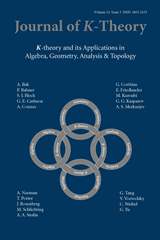Article contents
Morava K-theory rings for the groups G38, …, G41 of order 32
Published online by Cambridge University Press: 06 December 2013
Abstract
B. Schuster [19] proved that the mod 2 Morava K-theory K(s)*(BG) is evenly generated for all groups G of order 32. For the four groups G of order 32 with the numbers 38, 39, 40 and 41 in the Hall-Senior list [11], the ring K(2)*(BG) has been shown to be generated as a K(2)*-module by transferred Euler classes. In this paper, we show this for arbitrary s and compute the ring structure of K(s)*(BG). Namely, we show that K(s)*(BG) is the quotient of a polynomial ring in 6 variables over K(s)*(pt) by an ideal for which we list explicit generators.
- Type
- Research Article
- Information
- Copyright
- Copyright © ISOPP 2014
References
- 4
- Cited by


